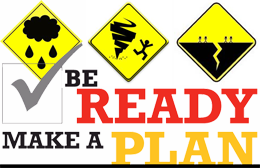- Monday - Friday8:00 AM - 5:00 PM
- Contact Us1-573-785-8478

This information was provided by the following agencies and for additional planning and weather preparedness information, please refer to the following websites:
Floods are one of the most common hazards in the United States. Not all floods are alike. Some develop slowly and some can occur within a matter of minutes. If a flood is likely in your area, 1) Listen to the radio or television for information. 2) Be aware that flash flooding can occur and move to higher ground. 3) Be aware of streams, drainage channels, canyons and other areas known to flood suddenly.
If you must evacuate, 1) Secure your home. Bring in outdoor furniture and move essential items to an upper floor. 2) Turn off utilities at the main switches or valves and disconnect electrical appliances. 3) Do not walk through moving water. Six inches of moving water can make you fall. Use a stick to check the firmness of the ground in front of you. 4) Do not drive in flooded areas. If water rises around the car, leave the car and go to higher ground. A foot of water will float many vehicles.
Guidelines for Food Establishments After Flooding 2017
If a tornado is approaching it is very important to have a family plan. The following are steps to take before a tornado approaches.
If you see any of these danger signs, be prepared to take shelter immediately.
If you are under a tornado WARNING, seek shelter immediately! If you are in a:
One of the most frightening and destructive phenomena of nature is a severe earthquake and its terrible aftereffects. Earthquakes strike suddenly, violently and without warning at any time of the day or night. If an earthquake occurs in a populated area, it may cause many deaths and injuries and extensive property damage. Although there are no guarantees of safety during an earthquake, identifying potential hazards ahead of time and advance planning can save lives and significantly reduce injuries and property damage.
There are six ways to plan ahead for an earthquake:
During an earthquake you want to minimize your movements to a few steps to a nearby safe place and stay indoors until the shaking has stopped and you are sure exiting is safe.
After an earthquake expect aftershocks. These secondary shockwaves are usually less violent than the main earthquake.
Before you enter your home walk carefully around the outside and check for loose power lines, gas leaks and structural damage. If you have any doubts about safety, do not enter until the house has been inspected by a building inspector.
Do not enter the house if:
Once it has been deemed safe to enter your home, check for:
Recovering from a disaster is usually a gradual process. Safety is a primary issue.
Emergency management organizations encourage citizens to keep disaster supplies, emergency food and water on hand in case of flood, power outage, tornado or earthquake. All of the following items will fit into a five-gallon bucket. The items are: 1 roll of toilet paper, 1 camp stove, 2 cans of Sterno, 1 mess kit, 4 boxes of water proof matches, 6 books of regular matches, 12 paper plates, 6 each plastic forks, knives and spoons, 12 disposable drinking cups, 1 flashlight, 2 AD batteries, 2 emergency solar blankets, 12 hand/foot warmers, 6 heavy duty plastic bags, 12 hand sanitizer packets, 2 light sticks, 1 roll of duct tape, 1 pocket (utility) knife, 1 hand can opener, a two punch can opener, 2 combs, 1 tube toothpaste, 2 toothbrushes and 1 first aid kit. Items for the first aid kit: 6 pairs plastic gloves, an 8 oz bottle contact lens saline (to irrigate and clean wounds), 6 knuckle band-aids, 6 regular band-aids, 6 Telfa pads, 1 roll tape, 1 tube antibiotic ointment, 3 burn gel packets, 6 wound wipes (Providone-Iodine), 2 stretch gauze, 2 instant ice compresses, 6 packets each of buffered aspirin and non-aspirin pain reliever, 1 each scissors and tweezers, a 4 oz bottle of Hydrogen Peroxide, and 6 sanitary napkins, which can be used to dress a large wound.
Did you know that a flood, fire, national disaster, or the loss of power from high winds, snow, or ice could jeopardize the safety of your food? Knowing how to determine if food is safe and how to keep food safe will help minimize the potential loss of food and reduce the risk of food borne illness. These tips will help you make the right decisions in keeping your family safe during an emergency.
Steps to follow to prepare for a possible weather emergency:
Steps to follow after the weather emergency:
Website Designed by Creative Design Group | Smart Marketing | Login | Forms Login | Email Login